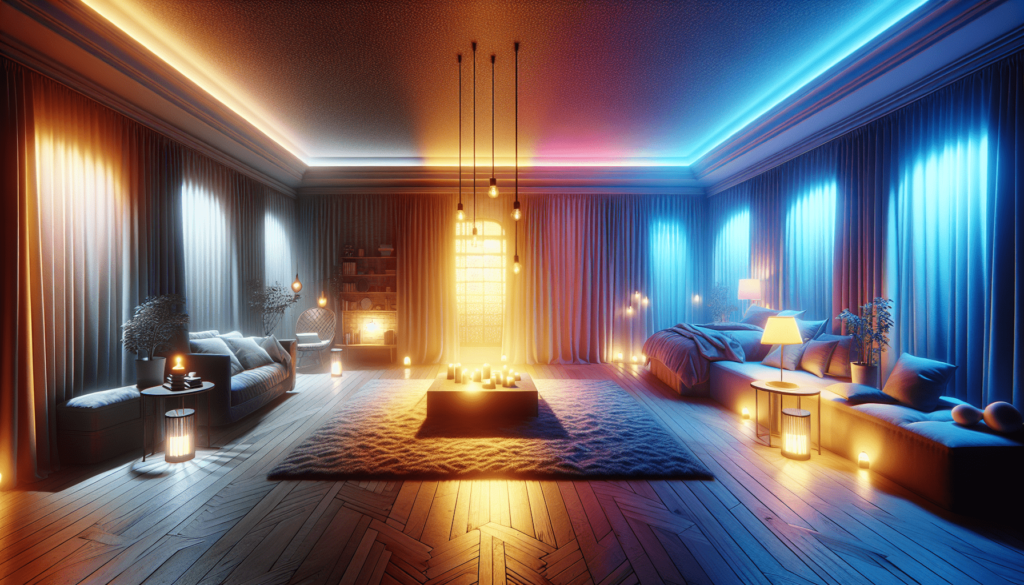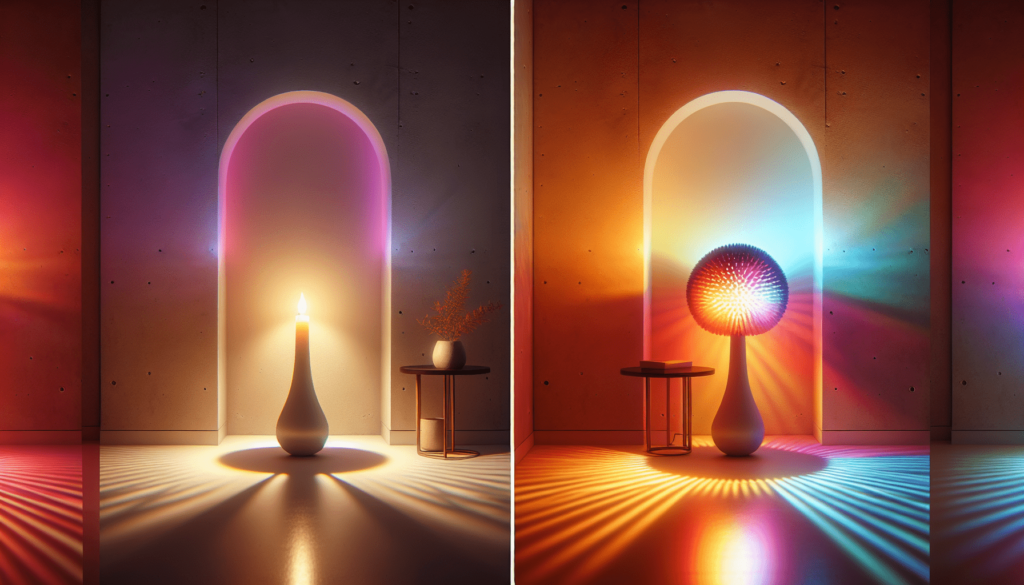Step into a world where lighting takes center stage and transforms your space into a haven of tranquility and ambiance. Discover the art of enhancing your surroundings through the mesmerizing techniques of mood lighting. From warm, inviting hues to dramatic shadows, this article will guide you on a journey to create an atmosphere that reflects your unique personality and brings warmth and serenity to any room. Whether you’re looking to relax after a long day or entertain with flair, these innovative techniques will help you illuminate your space and enhance your surroundings like never before.
Choosing the Right Lighting Fixtures
When it comes to choosing the right lighting fixtures for your space, it’s important to consider the purpose of the room. Different areas of your home require different types of lighting to create the right ambiance and functionality. By understanding the purpose of the space, you can select fixtures that meet your specific needs and enhance the overall aesthetic of the room.

Considering the Purpose of the Space
Before selecting lighting fixtures, take a moment to think about how you plan to use the room. Is it a cozy living area where you enjoy reading and relaxing? Or is it a bright and vibrant kitchen where you spend time cooking and entertaining? By considering the purpose of the space, you can determine the level of brightness and the type of lighting that will best suit your needs.
Identifying the Right Fixtures for Each Area
Different areas of your home serve different purposes, and each requires a specific type of lighting to optimize functionality. For example, in the kitchen, task lighting is essential to ensure you have ample illumination for food preparation. In the living room, ambient lighting can create a warm and inviting atmosphere. By identifying the right fixtures for each area, you can ensure that your lighting choices are tailored to meet your specific needs.
Exploring Different Types of Lighting Fixtures
There are various types of lighting fixtures available, each designed to serve a specific purpose. Some common options include chandeliers, pendant lights, wall sconces, table lamps, and floor lamps. By exploring the different types of lighting fixtures, you can find the perfect ones to complement the style and function of your space. Consider the size of the room, the height of the ceiling, and the overall design aesthetic when selecting your fixtures.
Understanding Different Lighting Techniques
To create the perfect lighting scheme for your space, it’s essential to understand the different lighting techniques available. Each technique provides a unique effect and can be utilized to elevate the overall ambiance of your room.
Ambient Lighting
Ambient lighting, also known as general lighting, provides overall illumination to a room. It serves as the base layer of lighting and ensures that the space is evenly lit. This technique can be achieved through the use of overhead fixtures, such as recessed lights or flush mounts. Ambient lighting sets the mood and provides a soft, pleasant glow throughout the room.
Task Lighting
Task lighting is designed to provide focused, bright illumination for specific activities. This technique is commonly used in areas where you need to perform tasks that require precision, such as reading, cooking, or working at a desk. Task lighting can be achieved through the use of desk lamps, under cabinet lights, or adjustable floor lamps. By incorporating task lighting into your space, you can ensure that you have ample light for activities that require focused attention.
Accent Lighting
Accent lighting is used to highlight specific objects or areas in a room. It adds depth and dimension to your space by creating visual interest and drawing attention to the features you want to emphasize. Accent lighting can be achieved through the use of track lighting, wall-mounted spotlights, or even picture lights. By strategically placing accent lighting fixtures, you can create a dramatic effect and enhance the overall aesthetic of your room.
Cove Lighting
Cove lighting involves the installation of light fixtures in recessed ledges or moldings. This technique creates an indirect, soft glow that adds a touch of elegance to any space. Cove lighting can be used to illuminate ceilings, walls, or even under cabinets, creating a warm and inviting atmosphere. It is particularly effective in areas where you want to minimize shadows and create a cozy ambiance.

Wall Washing
Wall washing is a technique that involves illuminating a wall with a wide beam of light to create an even wash or glow. This technique is commonly used to highlight textured surfaces, artwork, or architectural details. By casting light across the surface of a wall, you can create a visually striking effect that adds depth and dimension to your space.
Uplighting
Uplighting involves the placement of light fixtures at ground level, pointing the light upwards to illuminate objects or architectural features. This technique is often used to highlight tall plants, sculptures, or trees outdoors. Uplighting can create a dramatic effect, casting interesting shadows and creating a sense of height and grandeur.
Downlighting
Downlighting, as the name suggests, involves the installation of fixtures on the ceiling that direct light downwards. This technique is commonly used in areas where you need a focused, concentrated beam of light, such as above a dining table or kitchen island. Downlighting can create a cozy, intimate atmosphere and is often used to highlight specific areas in a room.
Shadow Lighting
Shadow lighting is a technique that uses light and shadow to create interesting patterns and visual effects. By strategically placing lights in front of objects or architectural features, you can cast shadows that add depth and intrigue to your space. Shadow lighting is commonly used in art galleries or restaurants to create a unique and captivating ambiance.
Creating Different Moods with Lighting
Lighting has the power to transform the mood of a room and create a specific atmosphere. By using different lighting techniques and fixtures, you can create various moods to suit different occasions and personal preferences.
Relaxing and Serene Ambiance
If you want to create a relaxing and serene ambiance in your space, opt for softer, diffused lighting. Use ambient lighting to create a gentle glow throughout the room, and incorporate dimmer switches to adjust the intensity of the light. Utilize warm, neutral colors to create a cozy and inviting environment. Consider adding accent lighting to highlight artworks or decorative elements, creating focal points that enhance the overall tranquility of the space.
Invigorating and Energetic Atmosphere
To create an invigorating and energetic atmosphere, choose brighter, more focused lighting. Incorporate task lighting in areas where you need to stay alert and focused, such as a home office or exercise room. Use cool, crisp colors to create a vibrant and lively environment. Consider utilizing uplighting to add drama and height to your space, casting interesting shadows that create a sense of energy and movement.
Romantic and Intimate Setting
For a romantic and intimate setting, opt for warm, dimmed lighting. Use soft, indirect lighting techniques like cove lighting or wall washing to create a cozy and inviting atmosphere. Incorporate accent lighting to highlight unique design elements or artworks, creating a sense of luxury and sophistication. Consider utilizing candlelight or fairy lights to add a touch of romance and create a magical ambiance.

Cozy and Comfortable Space
To create a cozy and comfortable space, select warm, ambient lighting. Incorporate table lamps and floor lamps with soft, diffused shades to create a warm and inviting glow. Utilize shadow lighting techniques to add depth and texture to your space, creating a sense of warmth and coziness. Consider layering lights with different intensities to create a soft, layered effect that mimics natural lighting and enhances the overall comfort of the room.
Using Color to Enhance the Mood
Color plays a significant role in setting the mood of a room. By choosing the right color scheme and utilizing different lighting techniques, you can enhance the overall ambiance and create a space that reflects your personal style.
Warm Colors for a Welcoming Feel
Warm colors, such as reds, yellows, and oranges, create a sense of warmth and coziness in a room. When paired with warm lighting, these colors can create a welcoming and inviting atmosphere. Consider using warm-colored lampshades, wall paint, or decorative accessories to enhance the overall effect. By combining warm colors with warm lighting, you can create a space that feels cozy and comfortable all year round.
Cool Colors for a Calming Effect
Cool colors, such as blues, greens, and purples, have a calming and soothing effect on a space. When paired with cool lighting, these colors can create a serene and tranquil ambiance. Consider using cool-colored lampshades, wall paint, or decorative elements to enhance the overall effect. By combining cool colors with cool lighting, you can create a space that feels refreshing and relaxing, perfect for unwinding after a long day.
Neutral Colors for Versatility
Neutral colors, such as whites, grays, and beiges, offer versatility and flexibility in design. When paired with different lighting techniques, neutral colors can create various moods and atmospheres. Consider using neutral-colored furniture, curtains, or carpets as a backdrop and focal point for your space. By incorporating warm or cool lighting, you can create a space that feels cozy or calming, depending on your desired ambiance.
Color-Change Options for Added Flexibility
If you want the flexibility to change the mood of your space on demand, consider using color-change options in your lighting fixtures. Many modern lighting fixtures offer color-changing capabilities, allowing you to switch between warm, cool, or even vibrant colors. With color-change options, you can easily adapt your space to different occasions or personal preferences. Whether you want a cozy movie night or a lively party atmosphere, color-change lighting can help you achieve the perfect ambiance.
Controlling Lighting Intensity and Brightness
Controlling the intensity and brightness of your lighting is crucial in creating the desired ambiance in your space. By utilizing different control options, you can adjust the lighting to suit your needs and preferences throughout the day.
Dimmer Switches for Adjustable Lighting
Dimmer switches are a great tool for controlling the intensity of your lighting. They allow you to adjust the brightness of the lights to create the desired ambiance. Whether you want bright, focused lighting for a task or a soft, dimmed glow for relaxation, dimmer switches provide the flexibility to customize your lighting to suit any occasion. Consider installing dimmer switches in areas where you need versatility, such as the living room, dining room, or bedroom.
Smart Lighting Systems for Convenient Control
Smart lighting systems offer the convenience of controlling your lights with a touch of a button or voice command. With smart lighting, you can easily adjust the intensity, color, and even scheduling of your lights through a mobile app or voice-controlled smart assistants. This technology allows you to create preset lighting scenes for different moods or activities and provides seamless control over your entire lighting system. Whether you’re at home or away, smart lighting systems offer convenience and flexibility in managing your space’s ambiance.

Layering Lights to Create Depth and Dimension
Layering lights is a technique that involves combining different types of lighting to create depth and dimension in a space. By using a combination of ambient, task, and accent lighting, you can create a visually striking effect that enhances the overall ambiance of your room. Consider using recessed lights for ambient lighting, pendant lights or table lamps for task lighting, and spotlights for accent lighting. By layering lights, you can create a layered effect that adds interest and visual appeal to your space.
Placement and Positioning of Lighting Fixtures
The placement and positioning of your lighting fixtures play a crucial role in creating an optimal lighting scheme. By carefully considering the distribution of light, highlighting focal points, and avoiding glare and shadows, you can ensure that your space is well-illuminated and visually appealing.
Balancing Light Distribution in the Room
To achieve a balanced light distribution in a room, it’s important to strategically place your lighting fixtures. Consider the size and shape of the room, as well as the purpose of each area, when determining the placement of your fixtures. Aim to have a mix of ambient, task, and accent lighting in different areas to ensure that the entire space is well-illuminated. By distributing the light evenly, you can create a visually cohesive and comfortable environment.
Highlighting Focal Points
Focal points are the elements in a room that draw the most attention. By strategically highlighting these focal points, you can create a visually appealing and dynamic space. Consider using accent lighting to illuminate artworks, architectural features, or statement pieces of furniture. By directing light towards focal points, you can create a sense of depth and visual interest in your space.
Avoiding Glare and Shadows
Glare and shadows can disrupt the overall lighting scheme and detract from the functionality of a room. When selecting and positioning your lighting fixtures, be mindful of potential glare or shadows they may create. Consider using fixtures with diffusers or shades to minimize glare and ensure a comfortable viewing experience. Test the placement of your fixtures to ensure that they do not cast unwanted shadows on surfaces or impede your ability to complete tasks.
Considering Different Perspectives
When designing your lighting scheme, consider the different perspectives from which your space will be viewed. Take into account how the lighting will appear when entering the room, standing or sitting in various areas, or even looking from adjacent spaces. By considering different perspectives, you can ensure that your lighting is visually appealing and functional from all angles. Walk through your space and observe how the lighting looks from different viewpoints to make any necessary adjustments.
Incorporating Natural Light in Design
Natural light is a valuable asset in enhancing the overall ambiance of a space. By incorporating natural light into your design, you can create a sense of openness, warmth, and connection with the outdoors.
Maximizing Window Placement
When designing your space, consider the placement and size of windows to maximize the amount of natural light entering the room. Larger windows, multiple windows, or floor-to-ceiling windows can flood your space with natural light, creating a bright and airy atmosphere. Also, consider the orientation and direction of the windows to optimize the amount of sunlight throughout the day.
Utilizing Skylights or Roof Windows
Skylights or roof windows are a fantastic way to bring natural light into areas that may not have access to traditional windows. They can be installed above stairwells, in walk-in closets, or even in bathrooms, providing ample natural light and creating a unique design feature. Skylights can fill a space with daylight, creating a sense of openness and connection with the sky above.

Choosing Window Treatments
When utilizing natural light, it’s essential to choose window treatments that allow for easy control of privacy and light filtration. Sheer curtains, blinds, or shades can be used to diffuse the natural light while still maintaining a level of privacy. Consider the function of the room and your desired level of privacy when selecting window treatments. Opt for light-colored fabrics or materials that allow natural light to pass through easily.
Utilizing Mirrors for Light Reflection
Mirrors are excellent tools for enhancing natural light in a space. By strategically placing mirrors across from windows or by using mirrored furniture or accessories, you can bounce natural light around the room, creating a bright and expansive atmosphere. Mirrors can also help amplify the effects of artificial lighting, making a smaller space feel larger and more open.
Using Light Bulbs to Set the Tone
The type of light bulbs you choose can significantly impact the overall ambiance and functionality of your space. By selecting the right light bulb, you can create the desired atmosphere, save energy, and enhance the overall aesthetics of your lighting scheme.
Incandescent Bulbs for Warmth
Incandescent bulbs have long been the traditional choice for warm and cozy lighting. They emit a soft, warm glow that is reminiscent of candlelight, creating a welcoming and comfortable ambiance. However, incandescent bulbs are not as energy-efficient as other options, so consider using them sparingly or in fixtures that require a warm lighting effect.
LED Bulbs for Energy Efficiency
LED bulbs are a modern and energy-efficient option for lighting your space. They consume significantly less energy than traditional incandescent bulbs and have a much longer lifespan. LED bulbs are available in various color temperatures, allowing you to create different moods and atmospheres. Whether you want warm, cool, or daylight-like lighting, LED bulbs can provide the perfect solution for your space.
Halogen Bulbs for Brightness
Halogen bulbs are known for their bright white light and excellent color rendering capabilities. They provide a crisp and clear illumination that is often used in task lighting or areas where high levels of brightness are required. Halogen bulbs are more efficient than incandescent bulbs and can provide a similar warm lighting effect. However, they do consume more energy and generate more heat, so use them judiciously and ensure proper ventilation.
Choosing the Right Color Temperature
Color temperature refers to the warmth or coolness of the light emitted by a bulb. It is measured in Kelvin (K). Lower Kelvin values, such as 2700K, emit warm, yellow light, creating a cozy and intimate atmosphere. Higher Kelvin values, around 5000K, emit cool, blue light, creating a bright and energizing effect. When selecting light bulbs, consider the color temperature that best suits the mood and functionality of your space.
Adding Decorative Lighting Elements
In addition to functional lighting fixtures, incorporating decorative lighting elements can elevate the overall aesthetic and style of your space. These elements add a touch of personality and charm, making your room feel more inviting and unique.
Chandeliers and Pendant Lights
Chandeliers and pendant lights are excellent statement pieces that can become the focal point of a room. They come in various styles, shapes, and sizes, allowing you to choose the perfect one that complements your overall design aesthetic. Whether you prefer a traditional crystal chandelier or a modern and sleek pendant light, these fixtures can add elegance and sophistication to any space.
Wall Sconces and Picture Lights
Wall sconces and picture lights serve both functional and decorative purposes. They can be used to highlight artworks, photographs, or architectural details, creating a focal point in your space. Wall sconces are available in a variety of designs, from traditional and ornate to modern and minimalist, allowing you to find the perfect match for your style.
Table Lamps and Floor Lamps
Table lamps and floor lamps offer versatility and flexibility in lighting your space. They can be easily moved and positioned to provide focused task lighting or ambient illumination. Table lamps come in various shapes, sizes, and designs, making them a great decorative addition to your space. Floor lamps can serve as a stylish statement piece while providing valuable lighting in areas where overhead fixtures are inaccessible.
Fairy Lights and String Lights
Fairy lights and string lights are a fun and whimsical way to add a touch of magic to your space. They can be draped along walls, hung from the ceiling, or woven through furniture to create a soft and enchanting ambiance. Fairy lights are especially popular for creating a cozy and intimate atmosphere in bedrooms, living rooms, or outdoor spaces. With endless design possibilities, fairy lights can be easily incorporated into any style of decor.
Automation and Smart Lighting Integration
Automation and smart lighting technology offer convenience and flexibility in managing your lighting scheme. By integrating automation systems and smart assistants into your space, you can easily control your lights with a touch of a button or a simple voice command.
Programmable Lighting Scenes
Programmable lighting scenes allow you to create preset lighting combinations for different activities or moods. With the click of a button, you can instantly adjust the lighting to suit your needs. For example, you may have a “Movie Night” scene that dims the lights to a cozy level or a “Dinner Party” scene that sets the perfect ambiance for entertaining. Programmable lighting scenes give you complete control over your lighting scheme and allow you to create the perfect atmosphere for any occasion.
Voice Control via Smart Assistants
Smart assistants, such as Amazon’s Alexa or Google Assistant, offer the convenience of controlling your lights with voice commands. By integrating your lighting system with a smart assistant, you can turn lights on or off, adjust brightness, or even change colors with a simple voice command. Voice control provides a hands-free solution to managing your lighting scheme and adds a touch of futuristic technology to your space.
Integration with Home Automation Systems
If you have a home automation system in place, consider integrating your lighting scheme for seamless control. Home automation systems allow you to control not only your lighting but also other connected devices, such as heating, security, and entertainment systems. By integrating your lighting system with your home automation system, you can create a truly intelligent and interconnected space. Imagine arriving home to a beautifully lit room or automating your lighting based on occupancy or time of day. The possibilities are endless with home automation and lighting integration.
In conclusion, choosing the right lighting fixtures and techniques is essential in enhancing your space. By considering the purpose of each area, exploring different lighting techniques, and incorporating natural light, you can create the perfect ambiance for every occasion. With the right placement and positioning of lighting fixtures, along with the appropriate use of color and light bulbs, you can transform your space into a warm, inviting, and visually appealing environment. Don’t forget to incorporate decorative lighting elements and take advantage of automation and smart lighting integration for added convenience and flexibility. So go ahead, unleash your creativity, and let lighting be the key to transforming your space into a sanctuary of warmth, style, and comfort.



